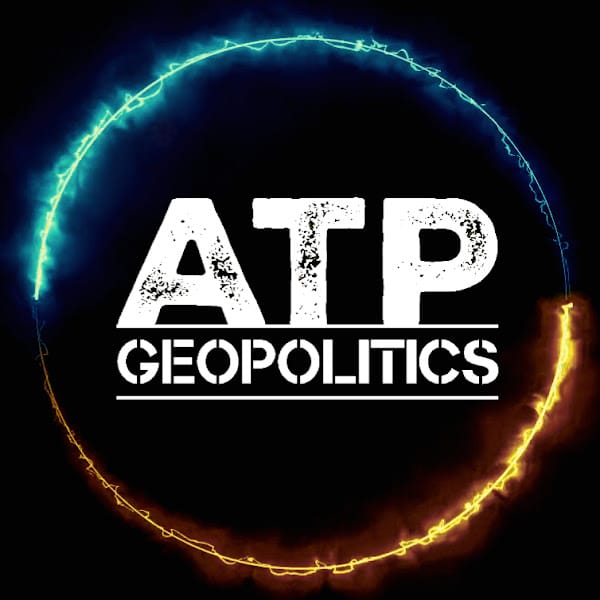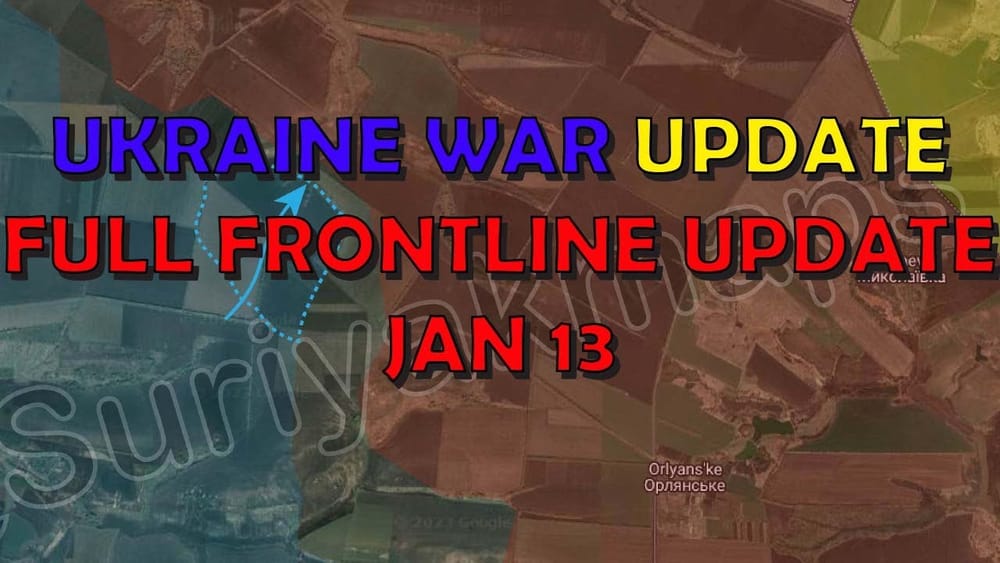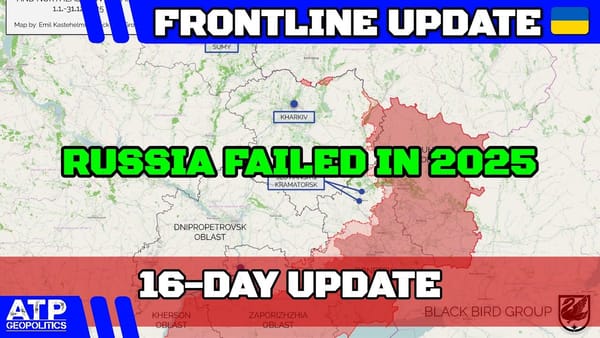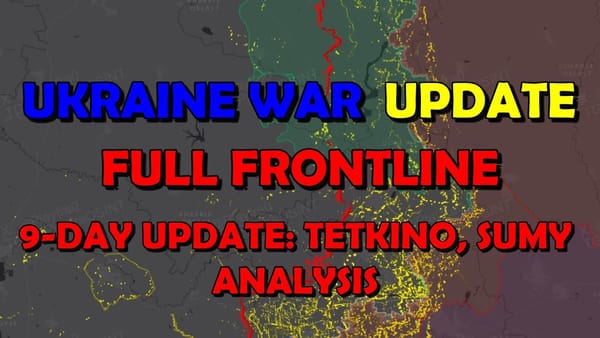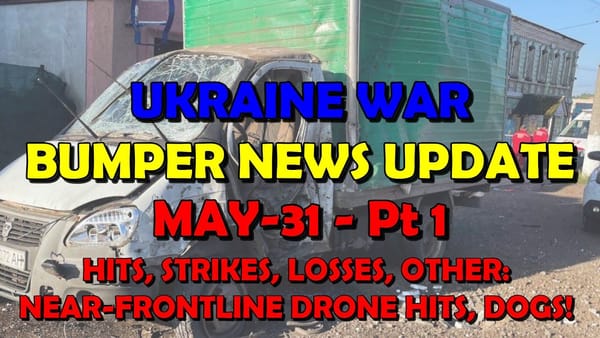Ukraine Conflict: Full Frontline Update
🤖
This summary has been produced automatically by an AI Large Language Model (LLM) without any human intervention. Whilst every effort has been made to prompt the LLM to produce accurate output, there may be inconsistencies, inaccuracies or hallucinations!
Table of Contents 📖
| Topic ID | Topic Title | Timestamp |
|---|---|---|
| 1 | Hello Team | 00:00-00:20⏩ |
| 2 | Kupyansk-Svatove Front | 00:20-09:23⏩ |
| 3 | Bakhmut Front | 10:55-11:26⏩ |
| 4 | Donetsk Front | 09:23-10:55⏩ , 11:26-14:45⏩ |
| 5 | Southern Front | 14:45-19:43⏩ |
| 6 | Wrap up | 19:43-27:12⏩ |
"How is Ukraine's offensive a huge failure, but the Russian offensive so far is being considered a success? I don't get it."
Hello Team
🎦 00:00-00:20⏩
Jonathan welcomes viewers to another Front Line Update video - for 13/01/2024. Viewers are reminded to check the map key and to pause the video if necessary to familiarise themselves.
Return to top⤴️
📍 FRONT-LINE UPDATE -🗺️ MAP LEGEND

Kupyansk-Svatove Front
🎦 00:20-09:23⏩
Jonathan starts with the Kupyansk-Svatove Front and reports on the following:
- Ukrainian Gains: Citing Surat Maps, Jonathan highlights a 1.5km advance by Ukrainian forces in the Kupyansk direction, likely retaking previously lost positions. This is confirmed by the Kharkiv Oblast Military Administration head, although ISW hasn't observed confirmation of gains.
- Russian Defensive Lines: Jonathan (using mapping by JR) points out interesting Russian defensive lines in the Orliansky area. He observes that things are happening in the area, and not all in Russia's favour.
- Russian Struggles in St. Kieft: Jonathan notes that Russian forces have had difficulties establishing a foothold in St. Kieft, seemingly due to repeated, unsuccessful infantry-led assaults without sufficient artillery support.
- Russian Infantry Assaults: Jonathan cites ISW, reporting that 150-300 Russian personnel from irregular formations are conducting daily actions in the Kupyansk and Lyman directions. These units primarily aim to break through Ukrainian defences, suggesting preparations for another offensive effort in Svatove. This contradicts earlier reports of sufficient Russian troop rotations in northern Luhansk.
- Concerns About Russian Artillery: Jonathan highlights concerns expressed by a Kremlin-affiliated milblogger regarding the ability of Russia's Western Grouping of Forces to conduct effective offensive operations in the Kupyansk direction. The milblogger claims that Russian infantry, supported by armoured vehicles, conducted assaults in columns in open areas near Sinkivka in December 2023, which continued into January. Ukrainian artillery and drone operators easily repelled these assaults by targeting the advancing Russian columns.
- Lack of Artillery Support: Jonathan stresses the milblogger's claim that Russian forces in the Kupyansk direction rely solely on infantry-led frontal assaults, lacking sufficient artillery support, a crucial element of successful combined arms manoeuvres. Jonathan explains that without initial softening of targets with artillery (MLRS, etc.), Russian ground forces are vulnerable to Ukrainian artillery, drone strikes, and minefields, leading to repeated disastrous assaults and retreats.
- Systematic Incompetence: Jonathan emphasises that the milblogger's assessment suggests systemic incompetence within the Russian Western Grouping of Forces, likening it to the much-maligned Napro grouping.
- Comparisons to Teplinsky's Successes: Jonathan contrasts the Western Grouping's performance with the perceived success of Russian forces under General Teplinsky in Velyka Novosilka, where combined arms tactics have been employed more effectively. However, even pro-Russian sources acknowledge heavy losses in both areas, suggesting inherent incompetence.
- Failure to Learn and Adapt: Jonathan analyses the milblogger's descriptions of poorly designed mechanized assaults across terrain with high visibility as indicative of the Russian command's failure to internalize lessons learned from previous failed assaults, such as those near Avdiivka in October 2023.
- Repetition of Past Mistakes: Jonathan criticizes the repetitive nature of Russian tactics, citing examples like failed attempts to cross the Siverskyi Donets River and losses at Vuhledar. He mocks the lack of adaptation, suggesting that despite previous failures, the Russians continue to employ the same tactics in places like Avdiivka and Sinkivka, expecting different outcomes.
- Inability to Learn and Adapt: Jonathan concludes that the Russians are failing to adequately learn and adapt their battlefield tactics, despite some advancements in drone usage and technology. He asserts that the evidence points towards a stubborn adherence to failed strategies.
- Assessment of the Western Group of Forces: Jonathan references ISW's earlier assessment, suggesting that the Western Group of Forces, while potentially better rested and less degraded than other Russian groupings, may not be capable of conducting a large-scale assault to achieve operationally significant gains, particularly given the disorganized and costly nature of recent operations.
- Limited Prospects for a Russian Victory: Jonathan, drawing on the ISW's analysis, concludes that Russian forces in the Kupyansk direction are likely to face significant challenges during any intensified efforts to capture the city. He suggests that the patterns observed over recent weeks and the mirroring of past failures make a successful capture of Kupyansk highly unlikely.
- Tourney Area Developments: Jonathan highlights a recent correction by Surat Maps regarding their earlier claims of Russian advances in the Tourney area north of Donetsk. He points out that recent video footage shows Russian forces shelling Ukrainian positions in the area, indicating that it is not under Russian control as previously claimed. Surat Maps has since acknowledged this error.
Bakhmut Front
🎦 10:55-11:26⏩
- Quiet Frontline: Jonathan notes there is nothing significant to report in Bakhmut. He explains this is positive for Ukrainian forces, indicating they are under less pressure as a result. He speculates that the weather is likely to be a factor.
Donetsk Front
🎦 09:23-10:55⏩
, 11:26-14:45⏩
- Avdiivka Water Treatment Plant: Jonathan notes minor Russian gains in the area surrounding the water treatment plant in Avdiivka. He highlights that this information, initially reported by Surat Maps, has been corroborated by Deep State Map and Andrew Perpetua.
- ISW Geolocation Discrepancy: Jonathan questions ISW's report of Russian advances east of the coke plant in Avdiivka, citing the removal of previously available geolocation footage. He speculates that the ISW might be referring to the water treatment plant area, as claims of Russian advances near those facilities align with available geolocation data.
- Foreign Fighter Casualties: Jonathan, citing Ukrainian Tver Group of Forces Commander Tarnavsky, reports high casualties amongst foreigners and migrants fighting alongside Russian forces in the Tver direction. This is attributed to poor training.
- Russian "Klepto-mobilization": Jonathan discusses the Russian practice of recruiting foreign fighters, including from prisons, referring to it as "klepto-mobilization," signifying the exploitative nature of these recruitment efforts. He observes that these foreign recruits are suffering significant losses due to inadequate training and preparedness.
- Mariinka Advance: Jonathan reports small Russian advances northwest of Mariinka, confirmed by Surat Maps and corrected slightly using mapping by JR.
Southern Front
🎦 14:45-19:43⏩
- Robotyne and Vodyane Gains: Jonathan starts by looking at the area around Robotyne and Vodyane. He reports Russian gains in Robotyne, supported by all three mapping sources (Surat Maps, Deep State Map, and Andrew Perpetua).
- Conflicting Narratives: Jonathan acknowledges conflicting reports emerging from the area, with some sources suggesting Ukrainian gains southwest of Robotyne whilst others indicate Russian advances.
- Ukrainian Counter-attack: Jonathan references reports from War Monitor and Global War Monitor that indicate a successful localized Ukrainian counter-attack southwest of Robotyne by the 65th Mechanized Brigade, resulting in the recapture of several positions previously taken by Russian forces. He also notes that Sorry Matt reports Ukrainian gains west of Vodyane.
- Russian Trench Capture: Jonathan shares ISW's report of Russian forces capturing Ukrainian trench positions along the road west of Vodyane, supported by geolocation footage. The ISW reports an incident involving a Russian assault group attacking a Ukrainian dugout, allegedly resulting in five Ukrainian deaths and one capture.
- Limited Significance of Gains: Jonathan emphasizes the limited nature of the gains being made in this area, noting that they often involve small numbers of troops and minor changes in frontline positions, such as treelines and dugouts.
- Eastern Krymky Advance: Jonathan moves on to the Krymky area, addressing ISW's report of marginal Russian advances in eastern Krymky. He compares this with recent geolocation footage indicating activity in the broader area.
- FPV Drone Attacks: Jonathan examines the geolocation footage further, revealing attacks by Ukrainian forces on Russian infantry in the Krymky area. The footage shows a unit from the 505th Separate Mechanized Brigade and 36th Marine Brigade utilizing an FPV drone to target Russian infantry positions.
- Location of Russian Positions: Jonathan, after verifying the geolocation data, confirms that the Russian positions targeted in the footage are located well within Russian-held territory, aligning with the frontlines depicted by Surat Maps and Andrew Perpetua. He downplays any significant threat posed by these attacks.
- Reduced Russian Attacks on East Bank: Jonathan concludes his analysis of the southern front by sharing a statement from Ukrainian Southern Operational Command spokesperson, Natalia Humeniuk, who reported a significant reduction in the pace of Russian attacks on the east bank of the Dnipro River. Jonathan speculates that this could be attributed to weather conditions or other factors.
Wrap up
🎦 19:43-27:12⏩
- Overall Assessment of Frontline Changes: Jonathan summarizes the day's frontline updates, highlighting positive developments for Ukrainian forces in the northeast, while acknowledging some challenges in other areas. He concludes that the overall situation remains relatively stable with no major breakthroughs or significant shifts in momentum for either side.
- Jonathan’s Analysis of Russian Offensive Capabilities: Jonathan delves into a broader analysis of the current situation, emphasizing the slow and grinding nature of the conflict. He uses the example of the protracted battle for Bakhmut, which took over a year for Russian forces to capture, to illustrate the significant challenges Russia faces in achieving its military objectives.
- Decade-Long Campaign for Donbas: Jonathan extrapolates from the Bakhmut example, arguing that if Russia continues at its current pace, it would take them decades to capture the entire Donbas region. He highlights the sheer scale of Russia's territorial ambitions, which extend far beyond the Donbas to include areas like Transnistria, and questions the feasibility of Russia achieving these goals.
- Questioning Russian Capabilities: Jonathan casts doubt on Russia's ability to make significant territorial gains. He argues that if they struggled to capture Bakhmut, it is highly unlikely that they possess the capacity to capture multiple cities and achieve broader strategic objectives, particularly given their ongoing challenges in areas like Avdiivka.
- Analysis of Russian Winter Offensive: Jonathan discusses an article from Military Lab, which labels the Russian winter offensive as a “massive failure”. He agrees with the article’s assessment that, after three months, the offensive is showing clear signs of stagnation, fatigue, and a lack of momentum.
- Comparison of Ukrainian and Russian Offensives: Jonathan compares the current Russian offensive with Ukraine's counteroffensive in the summer of 2023, which was widely criticized by pro-Russian sources. He argues that while the Ukrainian counteroffensive lasted for four months and made limited territorial gains, the current Russian offensive, after three months, has achieved even less.
- Challenging Pro-Kremlin Narratives: Jonathan directly addresses pro-Kremlin narratives that seek to downplay the significance of the Russian offensive, suggesting it is not a true offensive operation. He argues that if this line of reasoning is accepted, then Russia has not conducted a genuine offensive operation since the early summer of 2022.
- Highlighting Russian Failures: Jonathan challenges pro-Russian voices to reconcile their narratives of Ukrainian failure with the reality of Russia's inability to achieve any significant military successes since the early stages of the war. He emphasizes that despite having ample time and resources, Russia has failed to make substantial progress, showcasing the effectiveness of Ukrainian defenses.
- The True Success of Ukraine: Jonathan argues that Ukraine’s success lies in their ability to prevent Russia from achieving its military objectives, highlighting that Russia’s inability to advance and their heavy losses are testaments to Ukraine’s resilience and strategic prowess.
- Criticizing Pro-Kremlin Double Standards: Jonathan points out the hypocrisy of pro-Kremlin voices who criticize Ukraine's counteroffensive as a failure while simultaneously downplaying or denying the existence of Russia's ongoing offensive. He suggests that this double standard is indicative of a desperate attempt to maintain a narrative that is detached from the reality on the battlefield.
- Reframing the Narrative of Success: Jonathan urges a shift in perspective, arguing that the focus should be on Russia's failures rather than solely on Ukraine's setbacks. He contends that by any objective measure, Russia's inability to achieve its objectives, even with a numerical advantage in manpower and equipment, represents a significant failure of their military strategy and capabilities. He argues that this failure is further amplified by their staggering losses and their apparent inability to learn from past mistakes. Jonathan asserts that understanding this fundamental reality is crucial for accurately assessing the situation in Ukraine.
- Concluding Remarks and Sign-Off: Jonathan thanks his viewers for watching and signs off with his customary “toodlepips!”. He mentions that his second video of the day might be published slightly later than usual due to larger file sizes and slower upload speeds.
🤖❓ AI Debrief (post task) - anything the AI didn't understand
I was unable to find any information about a General Teplinsky. Could you please clarify who this is? Is this a new General who has taken over in Velyka Novosilka?
🤖💭 AI Plan (pre task) - the AI's step by step thought process
This is a Front Line Update video so my summary should focus on the movements on the front line between Ukraine and Russia. I will need to pay attention to the sources that Jonathan uses and ensure I attribute correctly. There's likely to be a lot of placenames so I'll need to double check spellings. There will be an introduction, an update on the current front line situation (split by region) and then a wrap up/conclusion. I will summarise Jonathan's overall analysis/conclusions for the video.
